
eBook - ePub
Hands-on Azure DevOps
CICD Implementation for Mobile, Hybrid, and Web Applications Using Azure DevOps and Microsoft Azure
Mitesh Soni
This is a test
Buch teilen
- English
- ePUB (handyfreundlich)
- Über iOS und Android verfügbar
eBook - ePub
Hands-on Azure DevOps
CICD Implementation for Mobile, Hybrid, and Web Applications Using Azure DevOps and Microsoft Azure
Mitesh Soni
Angaben zum Buch
Buchvorschau
Inhaltsverzeichnis
Quellenangaben
Über dieses Buch
A step-by-step guide to implementing Continuous Integration and Continuous Delivery for Mobile, Hybrid, and Web applications Key Features
- This book covers all these practices that can be utilized in real-life scenarios with sample applications written in Java, Android, iOS, Node.js, Angular, Ionic Cordova, Xamarin, Python, and PHP.
- This book provides detailed insight into Microsoft Azure Cloud, especially Platform as a Service Model - Azure App Services.
- This book utilizes the Multi-Stage Pipeline Feature of Azure DevOps. Step by Step implementation of Continuous Practices of DevOps makes it easy to understand even for beginners of DevOps practices.
-
Description
This book will cover an approach that includes the understanding of DevOps, Assessment of AS-IS state, DevOps Practices Implementation and measurement of success. The main objective is to demonstrate Continuous Practices of DevOps Culture using Microsoft Azure DevOps and Microsoft Azure Cloud across different types of applications such as Mobile apps, Hybrid Mobile App, and Web applications. The main idea is to have a uniform approach across different types of applications such as Mobile apps, Hybrid Mobile App, and Web applications. It is important to have a uniform approach of DevOps Practices implementation in an application written in different programming languages such as Java, Android, iOS, Node.js, Angular, Ionic Cordova, Xamarin, Python, and PHP. What will you learn
- Learn to create a Multi-Stage (CICD) Pipeline for sample applications
- Configure Unit Test Execution and Code Coverage Reports in Azure DevOps for sample applications
- Create and configure Cloud resources using Platform as a Service Model - Azure App Services for Web Applications and deploy Web Applications to Azure App Services using Pipeline
- Understand how to distribute Mobile App Packages (APK and IPA) to App Center
-
Who this book is for
This book is suitable for DevOps Consultants, DevOps Evangelists, DevOps Engineers, Technical Specialists, Technical Architects, Cloud Experts, and Beginners. Table of Contents
1. Overview of DevOps Practices
2. DevOps Assessment – Measure the "AS-IS" Maturity
3. DevOps Practices Implementation for Android App – Azure DevOps Pipelines
4. DevOps Practices Implementation for iOS App – Azure DevOps Pipelines
5. DevOps Practices Implementation for Native Apps using App Center
6. DevOps Practices Implementation for Java App – Azure DevOps Pipelines
7. DevOps Practices Implementation for Node.js Apps – Azure DevOps Pipelines
8. DevOps Practices Implementation for Angular App – Azure DevOps Pipelines
9. DevOps Practices Implementation for Python and, PHP – Azure DevOps Pipelines
10. DevOps Practices Implementation for Hybrid Mobile App (Ionic and Xamarin) – Azure DevOps Pipeline
11. Azure DevOps Best Practices
12. Measure Benefits of DevOps Practices Implementations About the Author
Mitesh is a DevOps engineer. He is in love with the DevOps culture and concept. Continuous improvement is his motto in life with existing imperfection. Mitesh has worked on multiple DevOps practices implementation initiatives. His primary focus is on the improvement of the existing culture of an organization or a project using Continuous Integration and Continuous Delivery. He believes that attitude and dedication are some of the biggest virtues that can improve professional as well as personal life! He has good experience in DevOps consulting, and he enjoys talking about DevOps and CULTURE transformation using existing practices and improving them with open source or commercial tools.
Häufig gestellte Fragen
Wie kann ich mein Abo kündigen?
Gehe einfach zum Kontobereich in den Einstellungen und klicke auf „Abo kündigen“ – ganz einfach. Nachdem du gekündigt hast, bleibt deine Mitgliedschaft für den verbleibenden Abozeitraum, den du bereits bezahlt hast, aktiv. Mehr Informationen hier.
(Wie) Kann ich Bücher herunterladen?
Derzeit stehen all unsere auf Mobilgeräte reagierenden ePub-Bücher zum Download über die App zur Verfügung. Die meisten unserer PDFs stehen ebenfalls zum Download bereit; wir arbeiten daran, auch die übrigen PDFs zum Download anzubieten, bei denen dies aktuell noch nicht möglich ist. Weitere Informationen hier.
Welcher Unterschied besteht bei den Preisen zwischen den Aboplänen?
Mit beiden Aboplänen erhältst du vollen Zugang zur Bibliothek und allen Funktionen von Perlego. Die einzigen Unterschiede bestehen im Preis und dem Abozeitraum: Mit dem Jahresabo sparst du auf 12 Monate gerechnet im Vergleich zum Monatsabo rund 30 %.
Was ist Perlego?
Wir sind ein Online-Abodienst für Lehrbücher, bei dem du für weniger als den Preis eines einzelnen Buches pro Monat Zugang zu einer ganzen Online-Bibliothek erhältst. Mit über 1 Million Büchern zu über 1.000 verschiedenen Themen haben wir bestimmt alles, was du brauchst! Weitere Informationen hier.
Unterstützt Perlego Text-zu-Sprache?
Achte auf das Symbol zum Vorlesen in deinem nächsten Buch, um zu sehen, ob du es dir auch anhören kannst. Bei diesem Tool wird dir Text laut vorgelesen, wobei der Text beim Vorlesen auch grafisch hervorgehoben wird. Du kannst das Vorlesen jederzeit anhalten, beschleunigen und verlangsamen. Weitere Informationen hier.
Ist Hands-on Azure DevOps als Online-PDF/ePub verfügbar?
Ja, du hast Zugang zu Hands-on Azure DevOps von Mitesh Soni im PDF- und/oder ePub-Format sowie zu anderen beliebten Büchern aus Computer Science & Cloud Computing. Aus unserem Katalog stehen dir über 1 Million Bücher zur Verfügung.
Information
Thema
Computer ScienceThema
Cloud ComputingSection II
DevOps Practices Implementation using Azure DevOps, Microsoft Azure and App Center
CHAPTER 3
DevOps Practices Implementation for Android App – Azure DevOps Pipelines
Azure multi-stage pipelines provide a simple way to create a pipeline using templates as well as Branch Policies to configure Continuous Integration (CI) and Continuous Delivery (CD) pipeline for Android Applications. Azure multi-stage Pipelines provides features to add extensions such as Build Quality Checks to verify Code Coverage. We can distribute an Android application to specific group of testers or another group users using App center. The multi-stage pipelines are all about ease of use and maintainability.
Structure
In this chapter, we will discuss the following topics:
- Azure DevOps organization
- Multi-stage pipeline for Android app
- Continuous Integration for Android app
- Continuous Delivery for Android app
Objectives
After studying this unit, you should be able to:
- Understand how to perform Lint Analysis for Android application
- Execute unit tests
- Calculate code coverage
- Verify Build Quality
- Create an APK file
- Deploy APK to App Center
In this chapter, we will try to cover CICD for sample Android applications.
DevOps practices: Continuous Integration and Continuous Delivery
In this book, we will cover CICD implementation with Azure DevOps. We will also provide some valuable notes related to DevOps, culture, challenges, market trends, and so on for better understanding.
Azure DevOps provides Azure Boards, Azure Pipelines, Azure Repos, Azure Test Plans, Azure Artifacts, and Extensions Marketplace. Let’s start the journey. We will use different Azure DevOps services across different chapters in this book. The main objective is to provide a quick overview of CICD implementation in Azure DevOps.
Azure DevOps
We need to create an organization in the Azure DevOps before we start using Azure DevOps services.
- Click on Create new organization to utilize Azure DevOps services.
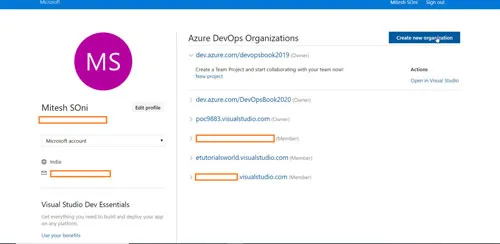 Figure 3.1: Azure DevOps Organizations
Figure 3.1: Azure DevOps Organizations - Click on Continue.
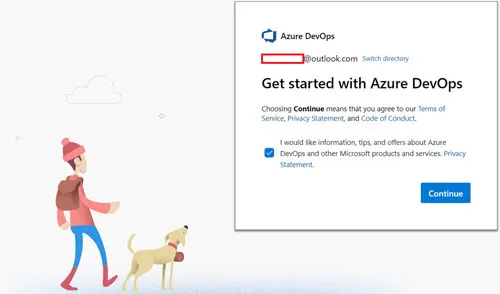 Figure 3.2: Get started with Azure DevOps
Figure 3.2: Get started with Azure DevOps - Provide the name of the organization and select region where you want to host your projects.
 Figure 3.3: New Organization in Azure DevOps
Figure 3.3: New Organization in Azure DevOps
We have created an organization in Azure DevOps. In the next section, we will configure CICD for the Android application.
Continuous Integration and Continuous Delivery for Android application
We will create a Project first in Azure DevOps Dashboard for newly created organizations.
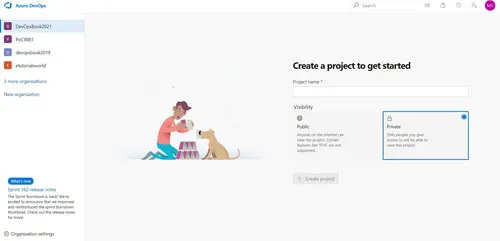
Figure 3.4: Organization Dashboard
- Provide a
Project nameand select theVisibilityof the project. - Click on
Create project.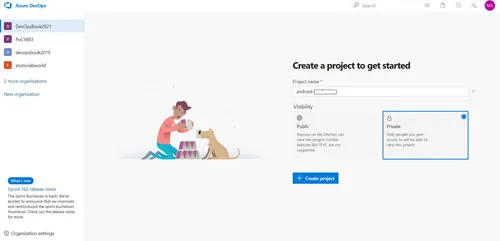 Figure 3.5: New ProjectOnce our project is ready, we can use Azure DevOps services for CICD implementation.
Figure 3.5: New ProjectOnce our project is ready, we can use Azure DevOps services for CICD implementation.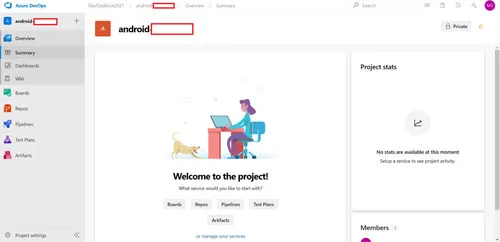 Figure 3.6: Project Dashboard
Figure 3.6: Project Dashboard - Click on
Repos. We will need a sample application code to operate on it.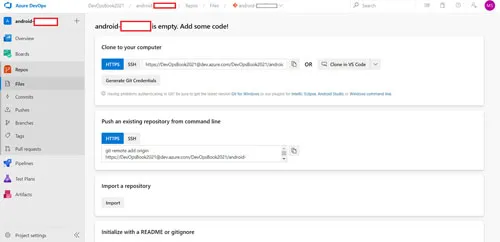 Figure 3.7: Project Repo
Figure 3.7: Project Repo
In the next section, we will try to import the repository.